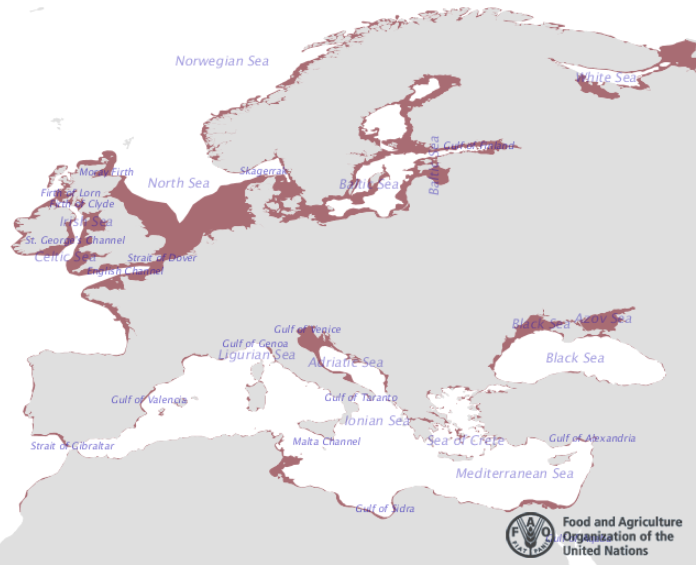Flounder

© Hans Hillewaert / , via Wikimedia Commons
Scientific name: Platichthys flesus
Also Known As: European Flounder, Fluke
MCRS: Within the legacy North Western Sea Fisheries Committee District 250mm. There is no EU MCRS for this species.
Description
Flounder is a typical right eyed flat fish (if the fish were to swim upright, both eyes would be on the right side of the body). Some individuals can be ‘reversed’ where the eyes are on the left side of the body which can make them difficult to identify. They have an oval body shape and vary in colour, but usually are dark green/brown with orange spots and a white belly – similar to plaice. Flounder can grow up to 50cm in length.
Habitat and Distribution

©FAO (Source Accessed 05/04/2018)
Flounder are found in coastal waters and estuaries around Britain and Ireland. They are a bottom dwelling species typically found resting on muddy substrates of estuaries. Flounder are a migratory species, mainly living in inshore water to a depth of around 50m and can move between salt water and fresh water environments.
Life Cycle, Reproduction and Feeding
Flounder mainly prey on invertebrates such as crustaceans, annelids and molluscs as well as other small fish. They feed during daylight hours and locate prey visually; adults have different feeding strategies to juveniles which results in less competition for food between the two life history stages.
Flounder spends most of its life in coastal waters but move into deeper, warmer waters in winter this can be up to 300 km offshore. The spawning population remains in the open sea to breed and spawning usually takes place from March to June migrate into the open sea. Males and females reach sexual maturity at different times; males mature at around 11cm length and females at around 17cm. Juveniles immigrate into estuaries in early May and settle on the seafloor where they live until they are ready to migrate and spawn, morphing into the flatfish form. Larval flatfish undergo an amazing transformation – whereby one eye migrates round to the same side of the head as the other.
In the NWIFCA District
Flounder, or fluke, is an important species in the NWIFCA District, reflected in the fact that the town of Flookburgh in Morecambe Bay takes its name from this fish. They are caught commercially by demersal nets and trawls. They are often a bycatch species in demersal sole and plaice fisheries and are often discarded due to a low commercial value. Flounder are commonly caught in shore based, fixed nets set within the District. They are not commonly sold to UK consumers, but can be sold as bait for crab and lobster pots. Flounder are also targeted by anglers, usually as a catch and release fish. Due to the widespread distribution and abundance it is considered a species of Least Concern by the International Union for the Conservation of Nature (IUCN).
Fisheries Management
There is a suite of netting Byelaws which vary for different parts of the District. There are also restrictions on mesh size of nets and features of trawls. Read more about this here.
Where commercial trawling and netting occurs in Marine Protected Areas it undergoes an assessment to ensure the activity does not cause risk to conservation features. HRAs carried out for trawling and netting in the District’s European Marine Sites can be found here.